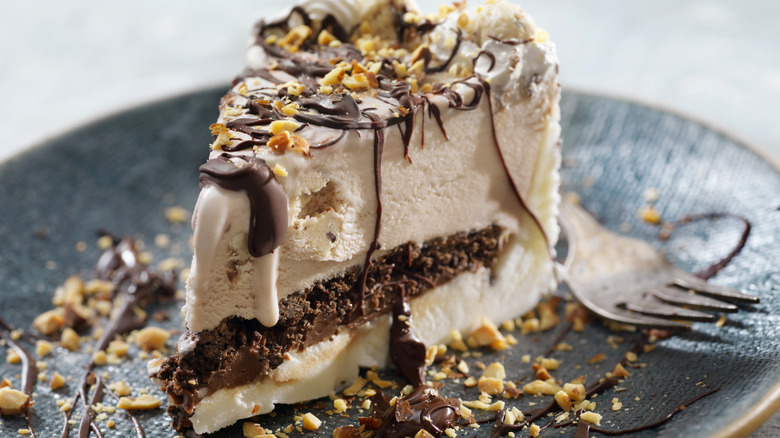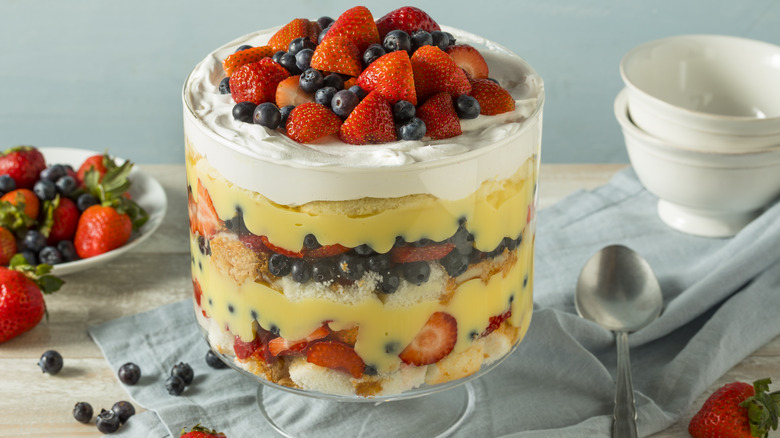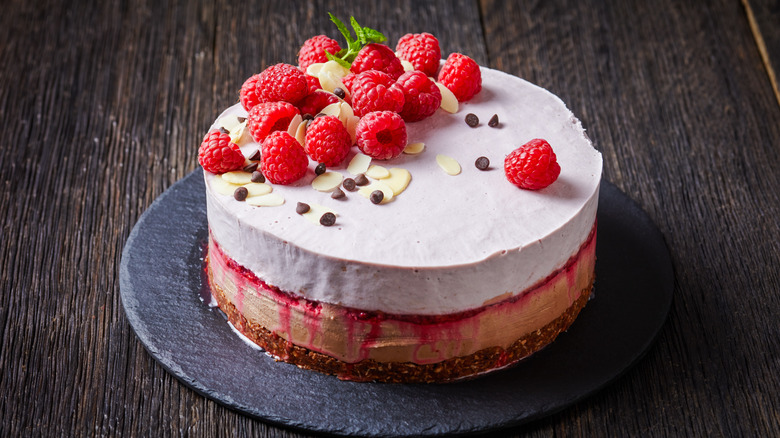The Mysterious Origins Of The Classic Ice Cream Cake
For many of us, a piece of birthday cake isn't complete without a hefty dollop of ice cream beside it. The age-old cake and ice cream pairing is taken one step further with the beloved ice cream cake, which has been around longer than you might think. Like many old recipes that have evolved, it isn't easy to pinpoint the exact beginnings of this frozen dessert. Its origins are unclear, leaving it open for food historians to speculate what could have been the first version of an ice cream cake.
Many theories trace its origins as far back as the 1300s to a popular Rennaisance dessert called a trifle. But it wasn't until later that it began to take the shape of something that could be called an ice cream cake. A popular French ice cream dessert may have inspired modern ice cream cakes, but of course, this dessert has many forms, from baked cakes with ice cream on top to cakes made entirely of layers of ice cream. Still, it's clear the sweet treats eaten centuries ago are not the unique ice cream cakes as we know them today.
Trifles and bombes
The ice cream cake may have evolved from the trifle, an English dessert that emerged in 18th-century Britain consisting of multiple layers of sponge cake, custard, and fruit. Trifles were created as a clever way to repurpose stale cake — cooks would soak spare cake scraps in alcohol and layer them in a glass bowl with creamy and fruity toppings, creating a tasty dessert and an eye-catching centerpiece. The traditional layered dessert wasn't frozen, but it's believed to have eventually inspired the modern ice cream cake.
Victorian-age cooks served trifles to dinner guests for various celebrations, often experimenting with the recipe and construction of the popular dessert. Taking pride in their beautifully constructed dessert, the cooks needed a way to prevent the custard from dripping and ruining the cake's structure as it waited to be served. The desserts were frozen to help their shape remain intact, resulting in something reminiscent of an ice cream cake.
It's also possible that the ice cream cake evolved from a dessert called bombes or bombe glacée. In the early 18th century, a French cook used a round mold to create an ice cream dessert shaped like a cannonball or a bomb, which was served at special occasions like weddings. There are multiple variations of bombe recipes, but the traditional round dessert consists of multiple layers of different-flavored ice cream and a hardened outer layer made from boiling sugar and water.
Ice cream cakes today
The English trifle and French bombe likely inspired ice cream cakes, which evolved over the years into frozen treats that everyone could enjoy with the help of household freezers. What was once considered a luxury only fit for the wealthy due to the difficult process of making and freezing ice cream became a popular dessert enjoyed by all starting in the mid-20th century, with help from store brands like Carvel, Dairy Queen, and Baskin-Robbins.
While there are plenty of amazing store-bought ice cream cakes, follow a few helpful tips, and you'll be on your way to making a better ice cream cake than Baskin-Robbins. For one, structural integrity is a crucial component for building your ice cream cake — it's important to plan out your ingredients ahead of time and create your layers with purpose. Starting with a non-ice cream base, such as sponge cake or brownies, is helpful because they freeze well. In addition, keeping your non-ice cream layers, like fudge, cookie crumbs, or fruit, relatively thin will help your cake maintain its structure.
You can pick whatever tasty flavor you want, but choosing a higher-quality ice cream will give you more time to assemble your cake, as most high-quality varieties stay frozen longer than their cheaper counterparts. Finally, the ice cream will soften as you build your cake, so prepare room in the freezer ahead of time so you can freeze it immediately after assembling it.


